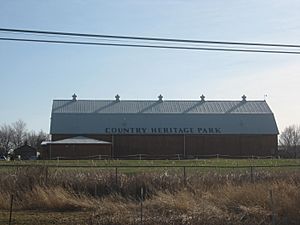Country Heritage Park facts for kids
 |
|
| Location | Milton, Ontario, Canada |
|---|---|
| Type | Events Venue, Agricultural museum & More! |
The Country Heritage Park is a special place in Milton, Ontario, Canada. It's right next to Highway 401 and the beautiful Niagara Escarpment. This park shows what rural life was like in Ontario during the 1800s. It's like stepping back in time! Besides being a museum, it also hosts events and even has a private school during the day. The park works with important groups like the Canadian Museums Association.
Contents
History of Country Heritage Park
The idea for this park came from the Ontario Ministry of Agriculture and Food. It officially started in 1967 with a special law called the Agricultural Museum Act. This happened after a collector named Charles Matthews shared his huge collection of old farm tools and items.
The first museum site was on 92 acres of land. It was near the Kelso Conservation Area in Milton. The land was bought in 1966 by Halton County, then by the Province of Ontario. The main goal was to show how farming in Ontario changed over time.
Building the Museum
The museum was built in three main steps. The first step, finished in 1973, involved preparing the land. Students from a local heavy equipment school helped build gravel roads and parking lots.
In 1974, the second step began. This included building the main museum building, which was 20,000 square feet. It was designed by architects from Oakville. The main exhibit hall was finished in 1975.
More and more people started visiting the museum. In 1976, about 3,000 people came. By 1977, that number grew to 5,000 guests. Even though it wasn't fully open, 10,000 visitors were expected in 1978. By 1979-80, they hoped for 30,000 visitors each year.
By 1977, the museum had a library with over 2,000 books. When staff first moved to the site, there was only one building. By mid-1978, 21 more buildings had been built. Many summer students helped with research and building displays. In 1978, the museum had between 12,000 and 15,000 items. Most of these items were donated.
The third step of the plan was to bring old pioneer farmhouses to the site. These homes would be fixed up to show different types of farming from various times in Ontario's history.
In 1977, the museum had seven full-time staff members. The general manager, Bob Carbert, said they needed more staff. They needed help to keep finding and fixing old items, and to welcome visitors.
The museum's big grand opening was planned for 1978. However, because they didn't have enough staff, it was delayed. By June 1978, only 90% of the indoor exhibits were ready.
The grand opening finally happened on June 8, 1979. It was marked by the loud whistle of a Sawyer-Massey steam engine. About 1,000 guests came to see the $1-million project open. Many important people were there, including Milton Mayor Don Gordon.
Changes in Operation
On April 1, 1997, the Ontario Government stopped running the site. In November 1997, it was announced that the museum would mostly close. This meant no public programs would be offered in 1998. The number of staff was cut from 23 to 10 full-time workers.
In March 1997, the government stopped funding the museum. This led to it becoming a private museum and its name changing to "Farm Museum." Eight months later, in November 1997, many staff members were laid off. This happened even though 40,000 visitors came that year.
The Ontario government still gave some money, a subsidy of $325,000 in 1997. Eventually, a non-profit group called Country Heritage Experience Inc. took over. Their main goal was to make the museum financially stable. They planned to do this by hosting events, charging admission, and renting out facilities.
From 1998 to 2001, the museum's income tripled. This was a big improvement for the 80-acre site. By 2001, it had four full-time staff and 10 part-time historical guides. It also had 20,000 artifacts and 30 exhibit buildings. Many volunteers helped out, giving 597 days of service in 2000.
New Name: Country Heritage Park
On March 24, 2000, the group running the park changed its name. It became "Country Heritage Park, A Farm and Country Experience." The new name was chosen to attract more people. They wanted to welcome younger visitors and those from cities to learn about farm life.
See also

